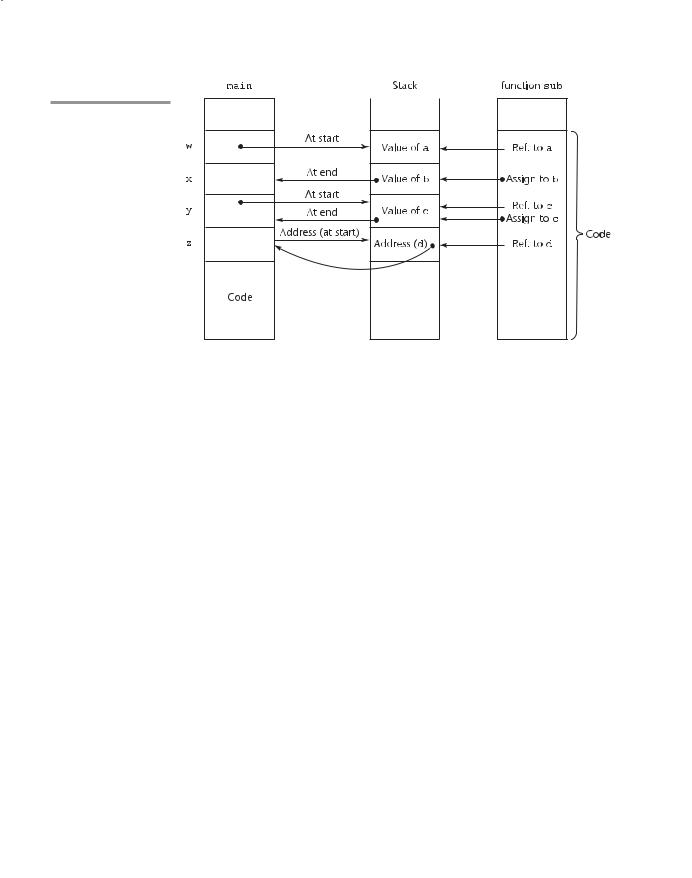
- •New to the Tenth Edition
- •Preface
- •Acknowledgments
- •About the Author
- •Contents
- •1.1 Reasons for Studying Concepts of Programming Languages
- •1.2 Programming Domains
- •1.3 Language Evaluation Criteria
- •1.4 Influences on Language Design
- •1.5 Language Categories
- •1.6 Language Design Trade-Offs
- •1.7 Implementation Methods
- •1.8 Programming Environments
- •Summary
- •Problem Set
- •2.1 Zuse’s Plankalkül
- •2.2 Pseudocodes
- •2.3 The IBM 704 and Fortran
- •2.4 Functional Programming: LISP
- •2.5 The First Step Toward Sophistication: ALGOL 60
- •2.6 Computerizing Business Records: COBOL
- •2.7 The Beginnings of Timesharing: BASIC
- •2.8 Everything for Everybody: PL/I
- •2.9 Two Early Dynamic Languages: APL and SNOBOL
- •2.10 The Beginnings of Data Abstraction: SIMULA 67
- •2.11 Orthogonal Design: ALGOL 68
- •2.12 Some Early Descendants of the ALGOLs
- •2.13 Programming Based on Logic: Prolog
- •2.14 History’s Largest Design Effort: Ada
- •2.15 Object-Oriented Programming: Smalltalk
- •2.16 Combining Imperative and Object-Oriented Features: C++
- •2.17 An Imperative-Based Object-Oriented Language: Java
- •2.18 Scripting Languages
- •2.19 The Flagship .NET Language: C#
- •2.20 Markup/Programming Hybrid Languages
- •Review Questions
- •Problem Set
- •Programming Exercises
- •3.1 Introduction
- •3.2 The General Problem of Describing Syntax
- •3.3 Formal Methods of Describing Syntax
- •3.4 Attribute Grammars
- •3.5 Describing the Meanings of Programs: Dynamic Semantics
- •Bibliographic Notes
- •Problem Set
- •4.1 Introduction
- •4.2 Lexical Analysis
- •4.3 The Parsing Problem
- •4.4 Recursive-Descent Parsing
- •4.5 Bottom-Up Parsing
- •Summary
- •Review Questions
- •Programming Exercises
- •5.1 Introduction
- •5.2 Names
- •5.3 Variables
- •5.4 The Concept of Binding
- •5.5 Scope
- •5.6 Scope and Lifetime
- •5.7 Referencing Environments
- •5.8 Named Constants
- •Review Questions
- •6.1 Introduction
- •6.2 Primitive Data Types
- •6.3 Character String Types
- •6.4 User-Defined Ordinal Types
- •6.5 Array Types
- •6.6 Associative Arrays
- •6.7 Record Types
- •6.8 Tuple Types
- •6.9 List Types
- •6.10 Union Types
- •6.11 Pointer and Reference Types
- •6.12 Type Checking
- •6.13 Strong Typing
- •6.14 Type Equivalence
- •6.15 Theory and Data Types
- •Bibliographic Notes
- •Programming Exercises
- •7.1 Introduction
- •7.2 Arithmetic Expressions
- •7.3 Overloaded Operators
- •7.4 Type Conversions
- •7.5 Relational and Boolean Expressions
- •7.6 Short-Circuit Evaluation
- •7.7 Assignment Statements
- •7.8 Mixed-Mode Assignment
- •Summary
- •Problem Set
- •Programming Exercises
- •8.1 Introduction
- •8.2 Selection Statements
- •8.3 Iterative Statements
- •8.4 Unconditional Branching
- •8.5 Guarded Commands
- •8.6 Conclusions
- •Programming Exercises
- •9.1 Introduction
- •9.2 Fundamentals of Subprograms
- •9.3 Design Issues for Subprograms
- •9.4 Local Referencing Environments
- •9.5 Parameter-Passing Methods
- •9.6 Parameters That Are Subprograms
- •9.7 Calling Subprograms Indirectly
- •9.8 Overloaded Subprograms
- •9.9 Generic Subprograms
- •9.10 Design Issues for Functions
- •9.11 User-Defined Overloaded Operators
- •9.12 Closures
- •9.13 Coroutines
- •Summary
- •Programming Exercises
- •10.1 The General Semantics of Calls and Returns
- •10.2 Implementing “Simple” Subprograms
- •10.3 Implementing Subprograms with Stack-Dynamic Local Variables
- •10.4 Nested Subprograms
- •10.5 Blocks
- •10.6 Implementing Dynamic Scoping
- •Problem Set
- •Programming Exercises
- •11.1 The Concept of Abstraction
- •11.2 Introduction to Data Abstraction
- •11.3 Design Issues for Abstract Data Types
- •11.4 Language Examples
- •11.5 Parameterized Abstract Data Types
- •11.6 Encapsulation Constructs
- •11.7 Naming Encapsulations
- •Summary
- •Review Questions
- •Programming Exercises
- •12.1 Introduction
- •12.2 Object-Oriented Programming
- •12.3 Design Issues for Object-Oriented Languages
- •12.4 Support for Object-Oriented Programming in Smalltalk
- •12.5 Support for Object-Oriented Programming in C++
- •12.6 Support for Object-Oriented Programming in Objective-C
- •12.7 Support for Object-Oriented Programming in Java
- •12.8 Support for Object-Oriented Programming in C#
- •12.9 Support for Object-Oriented Programming in Ada 95
- •12.10 Support for Object-Oriented Programming in Ruby
- •12.11 Implementation of Object-Oriented Constructs
- •Summary
- •Programming Exercises
- •13.1 Introduction
- •13.2 Introduction to Subprogram-Level Concurrency
- •13.3 Semaphores
- •13.4 Monitors
- •13.5 Message Passing
- •13.6 Ada Support for Concurrency
- •13.7 Java Threads
- •13.8 C# Threads
- •13.9 Concurrency in Functional Languages
- •13.10 Statement-Level Concurrency
- •Summary
- •Review Questions
- •Problem Set
- •14.1 Introduction to Exception Handling
- •14.2 Exception Handling in Ada
- •14.3 Exception Handling in C++
- •14.4 Exception Handling in Java
- •14.5 Introduction to Event Handling
- •14.6 Event Handling with Java
- •14.7 Event Handling in C#
- •Review Questions
- •Problem Set
- •15.1 Introduction
- •15.2 Mathematical Functions
- •15.3 Fundamentals of Functional Programming Languages
- •15.4 The First Functional Programming Language: LISP
- •15.5 An Introduction to Scheme
- •15.6 Common LISP
- •15.8 Haskell
- •15.10 Support for Functional Programming in Primarily Imperative Languages
- •15.11 A Comparison of Functional and Imperative Languages
- •Review Questions
- •Problem Set
- •16.1 Introduction
- •16.2 A Brief Introduction to Predicate Calculus
- •16.3 Predicate Calculus and Proving Theorems
- •16.4 An Overview of Logic Programming
- •16.5 The Origins of Prolog
- •16.6 The Basic Elements of Prolog
- •16.7 Deficiencies of Prolog
- •16.8 Applications of Logic Programming
- •Review Questions
- •Programming Exercises
- •Bibliography
- •Index

9.5 Parameter-Passing Methods |
399 |
The methods of C++, Java, and C# have only stack-dynamic local variables. In Python, the only declarations used in method definitions are for globals. Any variable declared to be global in a method must be a variable defined outside the method. A variable defined outside the method can be referenced in the method without declaring it to be global, but such a variable cannot be assigned in the method. If the name of a global variable is assigned in a method, it is implicitly declared to be a local and the assignment does not disturb the global. All local variables in Python methods are
stack dynamic.
Only variables with restricted scope are declared in Lua. Any block, including the body of a function, can declare local variables with the local declaration, as in the following:
local sum
All nondeclared variables in Lua are global. Access to local variables in Lua are faster than access to global variables according to Ierusalimschy (2006).
9.4.2Nested Subprograms
The idea of nesting subprograms originated with Algol 60. The motivation was to be able to create a hierarchy of both logic and scopes. If a subprogram is needed only within another subprogram, why not place it there and hide it from the rest of the program? Because static scoping is usually used in languages that allow subprograms to be nested, this also provides a highly structured way to grant access to nonlocal variables in enclosing subprograms. Recall that in Chapter 5, the problems introduced by this were discussed. For a long time, the only languages that allowed nested subprograms were those directly descending from Algol 60, which were Algol 68, Pascal, and Ada. Many other languages, including all of the direct descendants of C, do not allow subprogram nesting. Recently, some new languages again allow it. Among these are JavaScript, Python, Ruby, and Lua. Also, most functional programming languages allow subprograms to be nested.
9.5 Parameter-Passing Methods
Parameter-passing methods are the ways in which parameters are transmitted to and/or from called subprograms. First, we focus on the different semantics models of parameter-passing methods. Then, we discuss the various implementation models invented by language designers for these semantics models. Next, we survey the design choices of several languages and discuss the actual methods used to implement the implementation models. Finally, we

400 |
Chapter 9 Subprograms |
consider the design considerations that face a language designer in choosing among the methods.
9.5.1Semantics Models of Parameter Passing
Formal parameters are characterized by one of three distinct semantics models:
(1) They can receive data from the corresponding actual parameter; (2) they can transmit data to the actual parameter; or (3) they can do both. These models are called in mode, out mode, and inout mode, respectively. For example, consider a subprogram that takes two arrays of int values as parameters—list1 and list2. The subprogram must add list1 to list2 and return the result as a revised version of list2. Furthermore, the subprogram must create a new array from the two given arrays and return it. For this subprogram, list1 should be in mode, because it is not to be changed by the subprogram. list2 must be inout mode, because the subprogram needs the given value of the array and must return its new value. The third array should be out mode, because there is no initial value for this array and its computed value must be returned to the caller.
There are two conceptual models of how data transfers take place in parameter transmission: Either an actual value is copied (to the caller, to the called, or both ways), or an access path is transmitted. Most commonly, the access path is a simple pointer or reference. Figure 9.1 illustrates the three semantics models of parameter passing when values are copied.
9.5.2Implementation Models of Parameter Passing
Figure 9.1
The three semantics models of parameter passing when physical moves are used
A variety of models have been developed by language designers to guide the implementation of the three basic parameter transmission modes. In the following sections, we discuss several of these, along with their relative strengths and weaknesses.
|
Caller |
Call |
|
Callee |
|
|
(sub (a, b, c)) |
(void sub (int x, int y, int z)) |
|||
a |
|
|
|
|
x |
|
|
|
|
||
|
|
|
|
|
|
|
In mode |
|
|
|
|
|
|
Return |
|
|
|
|
|
|
|
|
|
b |
|
|
|
|
y |
|
|
|
|
|
|
|
Out mode |
Call |
|
|
|
|
|
|
|
|
|
c |
|
|
|
z |
|
|
|
|
|
|
Inout mode |
Return |
||

9.5 Parameter-Passing Methods |
401 |
9.5.2.1 Pass-by-Value
When a parameter is passedby value, the value of the actual parameter is used to initialize the corresponding formal parameter, which then acts as a local variable in the subprogram, thus implementing in-mode semantics.
Pass-by-value is normally implemented by copy, because accesses often are more efficient with this approach. It could be implemented by transmitting an access path to the value of the actual parameter in the caller, but that would require that the value be in a write-protected cell (one that can only be read). Enforcing the write protection is not always a simple matter. For example, suppose the subprogram to which the parameter was passed passes it in turn to another subprogram. This is another reason to use copy transfer. As we will see in Section 9.5.4, C++ provides a convenient and effective method for specifying write protection on pass-by-value parameters that are transmitted by access path.
The advantage of pass-by-value is that for scalars it is fast, in both linkage cost and access time.
The main disadvantage of the pass-by-value method if copies are used is that additional storage is required for the formal parameter, either in the called subprogram or in some area outside both the caller and the called subprogram. In addition, the actual parameter must be copied to the storage area for the corresponding formal parameter. The storage and the copy operations can be costly if the parameter is large, such as an array with many elements.
9.5.2.2 Pass-by-Result
Pass-by-result is an implementation model for out-mode parameters. When a parameter is passed by result, no value is transmitted to the subprogram. The corresponding formal parameter acts as a local variable, but just before control is transferred back to the caller, its value is transmitted back to the caller’s actual parameter, which obviously must be a variable. (How would the caller reference the computed result if it were a literal or an expression?)
The pass-by-result method has the advantages and disadvantages of pass- by-value, plus some additional disadvantages. If values are returned by copy (as opposed to access paths), as they typically are, pass-by-result also requires the extra storage and the copy operations that are required by pass-by-value. As with pass-by-value, the difficulty of implementing pass-by-result by transmitting an access path usually results in it being implemented by copy. In this case, the problem is in ensuring that the initial value of the actual parameter is not used in the called subprogram.
One additional problem with the pass-by-result model is that there can be an actual parameter collision, such as the one created with the call
sub(p1, p1)
In sub, assuming the two formal parameters have different names, the two can obviously be assigned different values. Then, whichever of the two is copied to

402 |
Chapter 9 Subprograms |
their corresponding actual parameter last becomes the value of p1 in the caller. Thus, the order in which the actual parameters are copied determines their value. For example, consider the following C# method, which specifies the pass-by-result method with the out specifier on its formal parameter.5
void Fixer(out int x, out int y) { x = 17;
y = 35;
}
...
f.Fixer(out a, out a);
If, at the end of the execution of Fixer, the formal parameter x is assigned to its corresponding actual parameter first, then the value of the actual parameter a in the caller will be 35. If y is assigned first, then the value of the actual parameter a in the caller will be 17.
Because the order can be implementation dependent for some languages, different implementations can produce different results.
Calling a procedure with two identical actual parameters can also lead to different kinds of problems when other parameter-passing methods are used, as discussed in Section 9.5.2.4.
Another problem that can occur with pass-by-result is that the implementor may be able to choose between two different times to evaluate the addresses of the actual parameters: at the time of the call or at the time of the return. For example, consider the following C# method and following code:
void DoIt(out int x, int index){ x = 17;
index = 42;
}
...
sub = 21; f.DoIt(list[sub], sub);
The address of list[sub] changes between the beginning and end of the method. The implementor must choose the time to bind this parameter to an address—at the time of the call or at the time of the return. If the address is computed on entry to the method, the value 17 will be returned to list[21]; if computed just before return, 17 will be returned to list[42]. This makes programs unportable between an implementation that chooses to evaluate the addresses for out-mode parameters at the beginning of a subprogram and one that chooses to do that evaluation at the end. An obvious way to avoid this problem is for the language designer to specify when the address to be used to return the parameter value must be computed.
5. The out specifier must also be specified on the corresponding actual parameter.

9.5 Parameter-Passing Methods |
403 |
9.5.2.3 Pass-by-Value-Result
Pass-by-value-result is an implementation model for inout-mode parameters in which actual values are copied. It is in effect a combination of pass-by-value and pass-by-result. The value of the actual parameter is used to initialize the corresponding formal parameter, which then acts as a local variable. In fact, pass-by-value-result formal parameters must have local storage associated with the called subprogram. At subprogram termination, the value of the formal parameter is transmitted back to the actual parameter.
Pass-by-value-result is sometimes called pass-by-copy, because the actual parameter is copied to the formal parameter at subprogram entry and then copied back at subprogram termination.
Pass-by-value-result shares with pass-by-value and pass-by-result the disadvantages of requiring multiple storage for parameters and time for copying values. It shares with pass-by-result the problems associated with the order in which actual parameters are assigned.
The advantages of pass-by-value-result are relative to pass-by-reference, so they are discussed in Section 9.5.2.4.
9.5.2.4 Pass-by-Reference
Pass-by-reference is a second implementation model for inout-mode parameters. Rather than copying data values back and forth, however, as in pass-by- value-result, the pass-by-reference method transmits an access path, usually just an address, to the called subprogram. This provides the access path to the cell storing the actual parameter. Thus, the called subprogram is allowed to access the actual parameter in the calling program unit. In effect, the actual parameter is shared with the called subprogram.
The advantage of pass-by-reference is that the passing process itself is efficient, in terms of both time and space. Duplicate space is not required, nor is any copying required.
There are, however, several disadvantages to the pass-by-reference method. First, access to the formal parameters will be slower than pass-by-value parameters, because of the additional level of indirect addressing that is required.6 Second, if only one-way communication to the called subprogram is required, inadvertent and erroneous changes may be made to the actual parameter.
Another problem of pass-by-reference is that aliases can be created. This problem should be expected, because pass-by-reference makes access paths available to the called subprograms, thereby providing access to nonlocal variables. The problem with these kinds of aliasing is the same as in other circumstances: It is harmful to readability and thus to reliability. It also makes program verification more difficult.
There are several ways pass-by-reference parameters can create aliases. First, collisions can occur between actual parameters. Consider a C++ function that has two parameters that are to be passed by reference (see Section 9.5.3), as in
6. This is further explained in Section 9.5.3.

404 |
Chapter 9 Subprograms |
void fun(int &first, int &second)
If the call to fun happens to pass the same variable twice, as in
fun(total, total)
then first and second in fun will be aliases.
Second, collisions between array elements can also cause aliases. For example, suppose the function fun is called with two array elements that are specified with variable subscripts, as in
fun(list[i], list[j])
If these two parameters are passed by reference and i happens to be equal to j, then first and second are again aliases.
Third, if two of the formal parameters of a subprogram are an element of an array and the whole array, and both are passed by reference, then a call such as
fun1(list[i], list)
could result in aliasing in fun1, because fun1 can access all elements of list through the second parameter and access a single element through its first parameter.
Still another way to get aliasing with pass-by-reference parameters is through collisions between formal parameters and nonlocal variables that are visible. For example, consider the following C code:
int * global; void main() {
...
sub(global);
...
}
void sub(int * param) {
...
}
Inside sub, param and global are aliases.
All these possible aliasing situations are eliminated if pass-by-value-result is used instead of pass-by-reference. However, in place of aliasing, other problems sometimes arise, as discussed in Section 9.5.2.3.
9.5.2.5 Pass-by-Name
Pass-by-name is an inout-mode parameter transmission method that does not correspond to a single implementation model. When parameters are passed by name, the actual parameter is, in effect, textually substituted for the corresponding

9.5 Parameter-Passing Methods |
405 |
formal parameter in all its occurrences in the subprogram. This method is quite different from those discussed thus far; in which case, formal parameters are bound to actual values or addresses at the time of the subprogram call. A pass-by- name formal parameter is bound to an access method at the time of the subprogram call, but the actual binding to a value or an address is delayed until the formal parameter is assigned or referenced. Implementing a pass-by-name parameter requires a subprogram to be passed to the called subprogram to evaluate the address or value of the formal parameter. The referencing environment of the passed subprogram must also be passed. This subprogram/referencing environment is a closure (see Section 9.12).7 Pass-by-name parameters are both complex to implement and inefficient. They also add significant complexity to the program, thereby lowering its readability and reliability.
Because pass-by-name is not part of any widely used language, it is not discussed further here. However, it is used at compile time by the macros in assembly languages and for the generic parameters of the generic subprograms in C++, Java 5.0, and C# 2005, as discussed in Section 9.9.
9.5.3Implementing Parameter-Passing Methods
We now address the question of how the various implementation models of parameter passing are actually implemented.
In most contemporary languages, parameter communication takes place through the run-time stack. The run-time stack is initialized and maintained by the run-time system, which manages the execution of programs. The runtime stack is used extensively for subprogram control linkage and parameter passing, as discussed in Chapter 10. In the following discussion, we assume that the stack is used for all parameter transmission.
Pass-by-value parameters have their values copied into stack locations. The stack locations then serve as storage for the corresponding formal parameters. Pass-by-result parameters are implemented as the opposite of pass-by- value. The values assigned to the pass-by-result actual parameters are placed in the stack, where they can be retrieved by the calling program unit upon termination of the called subprogram. Pass-by-value-result parameters can be implemented directly from their semantics as a combination of pass-by-value and pass-by-result. The stack location for such a parameter is initialized by the call and is then used like a local variable in the called subprogram.
Pass-by-reference parameters are perhaps the simplest to implement. Regardless of the type of the actual parameter, only its address must be placed in the stack. In the case of literals, the address of the literal is put in the stack. In the case of an expression, the compiler must build code to evaluate the expression just before the transfer of control to the called subprogram. The address of the memory cell in which the code places the result of its evaluation is then put in the stack. The compiler must be sure to prevent the called subprogram from changing parameters that are literals or expressions.
7.These closures were originally (in ALGOL 60) called thunks. Closures are discussed in Section 9.12.

406 |
Chapter 9 Subprograms |
Figure 9.2
One possible stack implementation of the common parameterpassing methods
Function header: void sub (int a, int b, int c, int d)
Function call in main: sub (w,x,y,z)
(pass w by value, x by result, y by value-result, z by reference)
Access to the formal parameters in the called subprogram is by indirect addressing from the stack location of the address. The implementation of pass- by-value, -result, -value-result, and -reference, where the run-time stack is used, is shown in Figure 9.2. Subprogram sub is called from main with the call sub(w, x, y, z), where w is passed by value, x is passed by result, y is passed by value-result, and z is passed by reference.
9.5.4Parameter-Passing Methods of Some Common Languages
C uses pass-by-value. Pass-by-reference (inout mode) semantics is achieved by using pointers as parameters. The value of the pointer is made available to the called function and nothing is copied back. However, because what was passed is an access path to the data of the caller, the called function can change the caller’s data. C copied this use of the pass-by-value method from ALGOL 68. In both C and C++, formal parameters can be typed as pointers to constants. The corresponding actual parameters need not be constants, for in such cases they are coerced to constants. This allows pointer parameters to provide the efficiency of pass-by-reference with the one-way semantics of pass-by-value. Write protection of those parameters in the called function is implicitly specified.
C++ includes a special pointer type, called a reference type, as discussed in Chapter 6, which is often used for parameters. Reference parameters are implicitly dereferenced in the function or method, and their semantics is pass- by-reference. C++ also allows reference parameters to be defined to be constants. For example, we could have

9.5 Parameter-Passing Methods |
407 |
histor y note
ALGOL 60 introduced the pass-by-name method. It also allows pass-by-value as an option. Primarily because of the difficulty in implementing them, pass-by-name parameters were not carried from ALGOL 60 to any subsequent languages that became popular (other than SIMULA 67).
histor y note
ALGOL W (Wirth and Hoare, 1966) introduced the pass-by- value-result method of parameter passing as an alternative to
the inefficiency of pass-by- name and the problems of pass-by-reference.
void fun(const int &p1, int p2, int &p3) { ... }
where p1 is pass-by-reference but cannot be changed in the function fun, p2 is pass-by-value, and p3 is pass-by-reference. Neither p1 nor p3 need be explicitly dereferenced in fun.
Constant parameters and in-mode parameters are not exactly alike. Constant parameters clearly implement in mode. However, in all of the common imperative languages except Ada, in-mode parameters can be assigned in the subprogram even though those changes are never reflected in the values of the corresponding actual parameters. Constant parameters can never be assigned.
As with C and C++, all Java parameters are passed by value. However, because objects can be accessed only through reference variables, object parameters are in effect passed by reference. Although an object reference passed as a parameter cannot itself be changed in the called subprogram, the referenced object can be changed if a method is available to cause the change. Because reference variables cannot point to scalar variables directly and Java does not have pointers, scalars cannot be passed by reference in Java (although a reference to an object that contains a scalar can).
Ada and Fortran 95 + allow the programmer to specify in mode, out mode, or inout mode on each formal parameter.
The default parameter-passing method of C# is pass-by- value. Pass-by-reference can be specified by preceding both a formal parameter and its corresponding actual parameter with ref. For example, consider the following C# skeletal method and call:
void sumer(ref int oldSum, int newOne) { ... }
...
sumer(ref sum, newValue);
The first parameter to sumer is passed by reference; the second is passed by value.
C# also supports out-mode parameters, which are pass-by-reference parameters that do not need initial values. Such parameters are specified in the formal parameter list with the out modifier.
PHP’s parameter passing is similar to that of C#, except that either the actual parameter or the formal parameter can specify pass-by-reference. Pass- by-reference is specified by preceding one or both of the parameters with an ampersand.
Perl employs a primitive means of passing parameters. All actual parameters are implicitly placed in a predefined array named @_ (of all things!). The subprogram retrieves the actual parameter values (or addresses) from this array. The most peculiar thing about this array is its magical nature, exposed by the fact that its elements are in effect aliases for the actual parameters. Therefore, if an element of @_ is changed in the called subprogram, that change is reflected in the corresponding actual parameter in the call, assuming there is a

408 |
Chapter 9 Subprograms |
corresponding actual parameter (the number of actual parameters need not be the same as the number of formal parameters) and it is a variable.
The parameter-passing method of Python and Ruby is called pass-by- assignment. Because all data values are objects, every variable is a reference to an object. In pass-by-assignment, the actual parameter value is assigned to the formal parameter. Therefore, pass-by-assignment is in effect pass-by-reference, because the value of all actual parameters are references. However, only in certain cases does this result in pass-by-reference parameter-passing semantics. For example, many objects are essentially immutable. In a pure object-oriented language, the process of changing the value of a variable with an assignment statement, as in
x = x + 1
does not change the object referenced by x. Rather, it takes the object referenced by x, increments it by 1, thereby creating a new object (with the value x + 1), and then changes x to reference the new object. So, when a reference to a scalar object is passed to a subprogram, the object being referenced cannot be changed in place. Because the reference is passed by value, even though the formal parameter is changed in the subprogram, that change has no effect on the actual parameter in the caller.
Now, suppose a reference to an array is passed as a parameter. If the corresponding formal parameter is assigned a new array object, there is no effect on the caller. However, if the formal parameter is used to assign a value to an element of the array, as in
list[3] = 47
the actual parameter is affected. So, changing the reference of the formal parameter has no effect on the caller, but changing an element of the array that is passed as a parameter does.
9.5.5Type Checking Parameters
It is now widely accepted that software reliability demands that the types of actual parameters be checked for consistency with the types of the corresponding formal parameters. Without such type checking, small typographical errors can lead to program errors that may be difficult to diagnose because they are not detected by the compiler or the run-time system. For example, in the function call
result = sub1(1)
the actual parameter is an integer constant. If the formal parameter of sub1 is a floating-point type, no error will be detected without parameter type checking. Although an integer 1 and a floating-point 1 have the same value, the

9.5 Parameter-Passing Methods |
409 |
representations of these two are very different. sub1 cannot produce a correct result given an integer actual parameter value when it expects a floating-point value.
Early programming languages, such as Fortran 77 and the original version of C, did not require parameter type checking; most later languages require it. However, the relatively recent languages Perl, JavaScript, and PHP do not.
C and C++ require some special discussion in the matter of parameter type checking. In the original C, neither the number of parameters nor their types were checked. In C89, the formal parameters of functions can be defined in two ways. They can be defined as in the original C; that is, the names of the parameters are listed in parentheses and the type declarations for them follow, as in the following function:
double sin(x)
double x;
{ ... }
Using this method avoids type checking, thereby allowing calls such as
double value;
int count;
...
value = sin(count);
to be legal, although they are never correct.
The alternative to the original C definition approach is called the prototype method, in which the formal parameter types are included in the list, as in
double sin(double x)
{ ... }
If this version of sin is called with the same call, that is, with the following, it is also legal:
value = sin(count);
The type of the actual parameter (int) is checked against that of the formal parameter (double). Although they do not match, int is coercible to double (it is a widening coercion), so the conversion is done. If the conversion is not possible (for example, if the actual parameter had been an array) or if the number of parameters is wrong, then a semantics error is detected. So in C89, the user chooses whether parameters are to be type checked.
In C99 and C++, all functions must have their formal parameters in prototype form. However, type checking can be avoided for some of the parameters by replacing the last part of the parameter list with an ellipsis, as in
int printf(const char* format_string, ...);

410 |
Chapter 9 Subprograms |
A call to printf must include at least one parameter, a pointer to a literal character string. Beyond that, anything (including nothing) is legal. The way printf determines whether there are additional parameters is by the presence of format codes in the string parameter. For example, the format code for integer output is %d. This appears as part of the string, as in the following:
printf("The sum is %d\n", sum);
The % tells the printf function that there is one more parameter.
There is one more interesting issue with actual to formal parameter coercions when primitives can be passed by reference, as in C#. Suppose a call to a method passes a float value to a double formal parameter. If this parameter is passed by value, the float value is coerced to double and there is no problem. This particular coercion is very useful, for it allows a library to provide double versions of subprograms that can be used for both float and double values. However, suppose the parameter is passed by reference. When the value of the double formal parameter is returned to the float actual parameter in the caller, the value will overflow its location. To avoid this problem, C# requires the type of a ref actual parameter to match exactly the type of its corresponding formal parameter (no coercion is allowed).
In Python and Ruby, there is no type checking of parameters, because typing in these languages is a different concept. Objects have types, but variables do not, so formal parameters are typeless. This disallows the very idea of type checking parameters.
9.5.6Multidimensional Arrays as Parameters
The storage-mapping functions that are used to map the index values of references to elements of multidimensional arrays to addresses in memory were discussed at length in Chapter 6. In some languages, such as C and C++, when a multidimensional array is passed as a parameter to a subprogram, the compiler must be able to build the mapping function for that array while seeing only the text of the subprogram (not the calling subprogram). This is true because the subprograms can be compiled separately from the programs that call them. Consider the problem of passing a matrix to a function in C. Multidimensional arrays in C are really arrays of arrays, and they are stored in row major order. Following is a storage-mapping function for row major order for matrices when the lower bound of all indices is 0 and the element size is 1:
address(mat[i, j]) = address(mat[0,0]) + i * number_of_columns + j
Notice that this mapping function needs the number of columns but not the number of rows. Therefore, in C and C++, when a matrix is passed as a

9.5 Parameter-Passing Methods |
411 |
parameter, the formal parameter must include the number of columns in the second pair of brackets. This is illustrated in the following skeletal C program:
void fun(int matrix[][10]) {
... }
void main() {
int mat[5][10];
...
fun(mat);
...
}
The problem with this method of passing matrixes as parameters is that it does not allow a programmer to write a function that can accept matrixes with different numbers of columns; a new function must be written for every matrix with a different number of columns. This, in effect, disallows writing flexible functions that may be effectively reusable if the functions deal with multidimensional arrays. In C and C++, there is a way around the problem because of their inclusion of pointer arithmetic. The matrix can be passed as a pointer, and the actual dimensions of the matrix also can be passed as parameters. Then, the function can evaluate the user-written storage-mapping function using pointer arithmetic each time an element of the matrix must be referenced. For example, consider the following function prototype:
void fun(float *mat_ptr,
int num_rows,
int num_cols);
The following statement can be used to move the value of the variable x to the [row][col] element of the parameter matrix in fun:
*(mat_ptr + (row * num_cols) + col) = x;
Although this works, it is obviously difficult to read, and because of its complexity, it is error prone. The difficulty with reading this can be alleviated by using a macro to define the storage-mapping function, such as
#define mat_ptr(r,c) (*mat_ptr + ((r) *
(num_cols) + (c)))
With this, the assignment can be written as
mat_ptr(row,col) = x;
Other languages use different approaches to dealing with the problem of passing multidimensional arrays. Ada compilers are able to determine the defined

412 |
Chapter 9 Subprograms |
size of the dimensions of all arrays that are used as parameters at the time subprograms are compiled. In Ada, unconstrained array types can be formal parameters. An unconstrained array type is one in which the index ranges are not given in the array type definition. Definitions of variables of unconstrained array types must include index ranges. The code in a subprogram that is passed an unconstrained array can obtain the index range information of the actual parameter associated with such parameters. For example, consider the following definitions:
type Mat_Type is array (Integer range <>,
Integer range <>) of Float;
Mat_1 : Mat_Type(1..100, 1..20);
A function that returns the sum of the elements of arrays of Mat_Type type follows:
function Sumer(Mat : in Mat_Type) return Float is
Sum : Float := 0.0;
begin
for Row in Mat'range(1) loop for Col in Mat'range(2) loop
Sum := Sum + Mat(Row, Col); end loop; -- for Col ...
end loop; -- for Row ...
return Sum;
end Sumer;
The range attribute returns the subscript range of the named subscript of the actual parameter array, so this works regardless of the size or index ranges of the parameter.
In Fortran, the problem is addressed in the following way. Formal parameters that are arrays must have a declaration after the header. For singledimensioned arrays, the subscripts in such declarations are irrelevant. But for multidimensional arrays, the subscripts in such declarations allow the compiler to build the storage-mapping function. Consider the following example skeletal Fortran subroutine:
Subroutine Sub(Matrix, Rows, Cols, Result)
Integer, Intent(In) :: Rows, Cols
Real, Dimension(Rows, Cols), Intent(In) :: Matrix
Real, Intent(In) :: Result
...
End Subroutine Sub
This works perfectly as long as the Rows actual parameter has the value used for the number of rows in the definition of the passed matrix. The number of rows is needed because Fortran stores arrays in column major order. If the array to be passed is not currently filled with useful data to the defined size,

9.5 Parameter-Passing Methods |
413 |
then both the defined index sizes and the filled index sizes can be passed to the subprogram. Then, the defined sizes are used in the local declaration of the array, and the filled index sizes are used to control the computation in which the array elements are referenced. For example, consider the following Fortran subprogram:
Subroutine Matsum(Matrix, Rows, Cols, Filled_Rows,
Filled_Cols, Sum)
Real, Dimension(Rows, Cols), Intent(In) :: Matrix
Integer, Intent(In) :: Rows, Cols, Filled_Rows,
Filled_Cols
Real, Intent(Out) :: Sum
Integer :: Row_Index, Col_Index
Sum = 0.0
Do Row_Index = 1, Filled_Rows
Do Col_Index = 1, Filled_Cols
Sum = Sum + Matrix(Row_Index, Col_Index)
End Do
End Do
End Subroutine Matsum
Java and C# use a technique for passing multidimensional arrays as parameters that is similar to that of Ada. In Java and C#, arrays are objects. They are all single dimensioned, but the elements can be arrays. Each array inherits a named constant (length in Java and Length in C#) that is set to the length of the array when the array object is created. The formal parameter for a matrix appears with two sets of empty brackets, as in the following Java method that does what the Ada example function Sumer does:
float sumer(float mat[][]) { float sum = 0.0f;
for (int row = 0; row < mat.length; row++) {
for (int col = 0; col < mat[row].length; col++) { sum += mat[row][col];
}//** for (int row ...
}//** for (int col ...
return sum;
}
Because each array has its own length value, in a matrix the rows can have different lengths.
9.5.7Design Considerations
Two important considerations are involved in choosing parameter-passing methods: efficiency and whether one-way or two-way data transfer is needed.

414 |
Chapter 9 Subprograms |
Contemporary software-engineering principles dictate that access by subprogram code to data outside the subprogram should be minimized. With this goal in mind, in-mode parameters should be used whenever no data are to be returned through parameters to the caller. Out-mode parameters should be used when no data are transferred to the called subprogram but the subprogram must transmit data back to the caller. Finally, inout-mode parameters should be used only when data must move in both directions between the caller and the called subprogram.
There is a practical consideration that is in conflict with this principle. Sometimes it is justifiable to pass access paths for one-way parameter transmission. For example, when a large array is to be passed to a subprogram that does not modify it, a one-way method may be preferred. However, pass-by-value would require that the entire array be moved to a local storage area of the subprogram. This would be costly in both time and space. Because of this, large arrays are often passed by reference. This is precisely the reason why the Ada 83 definition allowed implementors to choose between the two methods for structured parameters. C++ constant reference parameters offer another solution. Another alternative approach would be to allow the user to choose between the methods.
The choice of a parameter-passing method for functions is related to another design issue: functional side effects. This issue is discussed in Section 9.10.
9.5.8Examples of Parameter Passing
Consider the following C function:
void swap1(int a, int b) {
int temp = a;
a = b;
b = temp;
}
Suppose this function is called with
swap1(c, d);
Recall that C uses pass-by-value. The actions of swap1 can be described by the following pseudocode:
a = c — Move first parameter value in
b = d — Move second parameter value in
temp = a
a = b
b = temp
Although a ends up with d’s value and b ends up with c’s value, the values of c and d are unchanged because nothing is transmitted back to the caller.

9.5 Parameter-Passing Methods |
415 |
We can modify the C swap function to deal with pointer parameters to achieve the effect of pass-by-reference:
void swap2(int *a, int *b) {
int temp = *a;
*a = *b;
*b = temp;
}
swap2 can be called with
swap2(&c, &d);
The actions of swap2 can be described with
a |
= |
&c |
— |
Move |
first parameter address in |
b |
= |
&d |
— |
Move |
second parameter address in |
temp = *a
*a = *b
*b = temp
In this case, the swap operation is successful: The values of c and d are in fact interchanged. swap2 can be written in C++ using reference parameters as follows:
void swap2(int &a, int &b) {
int temp = a;
a = b;
b = temp;
}
This simple swap operation is not possible in Java, because it has neither pointers nor C++’s kind of references. In Java, a reference variable can point to only an object, not a scalar value.
The semantics of pass-by-value-result is identical to those of pass-by- reference, except when aliasing is involved. Recall that Ada uses pass-by-value- result for inout-mode scalar parameters. To explore pass-by-value-result, consider the following function, swap3, which we assume uses pass-by-value- result parameters. It is written in a syntax similar to that of Ada.
procedure swap3(a : in out Integer, b : in out Integer) is temp : Integer;
begin
temp := a; a := b;
b := temp; end swap3;

416 |
Chapter 9 Subprograms |
Suppose swap3 is called with
swap3(c, d);
The actions of swap3 with this call are
addr_c = &c |
— Move first parameter address in |
addr_d = &d |
— Move second parameter address in |
a = *addr_c |
— Move first parameter value in |
b = *addr_d |
— Move second parameter value in |
temp = a |
|
a = b |
|
b = temp |
|
*addr_c = a |
— Move first parameter value out |
*addr_d = b |
— Move second parameter value out |
So once again, this swap subprogram operates correctly. Next, consider the call
swap3(i, list[i]);
In this case, the actions are
addr_i = &i — Move first parameter address in
addr_listi= &list[i] — Move second parameter address in
a = *addr_i |
— Move first parameter value in |
b = *addr_listi |
— Move second parameter value in |
temp = a |
|
a = b |
|
b = temp |
|
*addr_i = a |
— Move first parameter value out |
*addr_listi = b |
— Move second parameter value out |
Again, the subprogram operates correctly, in this case because the addresses to which to return the values of the parameters are computed at the time of the call rather than at the time of the return. If the addresses of the actual parameters were computed at the time of the return, the results would be wrong.
Finally, we must explore what happens when aliasing is involved with pass- by-value-result and pass-by-reference. Consider the following skeletal program written in C-like syntax:
int i = 3; /* i is a global variable */ void fun(int a, int b) {
i = b;
}
void main() { int list[10];
